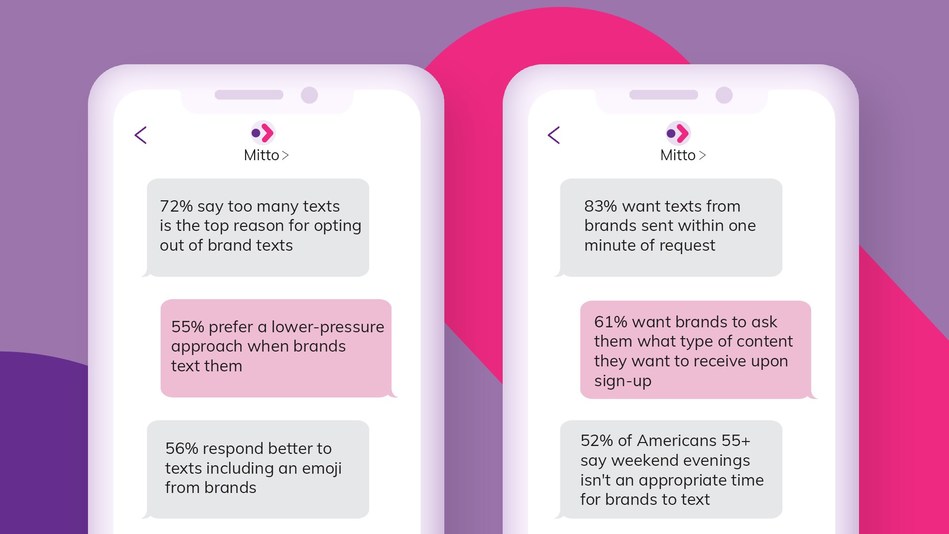There are lots of channels out there, and plenty of opportunities for brands to connect with consumers. But Americans are clear fans of texting, and brands should take advantage of this always-engaging platform by using the right approach, reveals new research from omnichannel comms firm Mitto, which examined how and when Americans want brands to message them.
The firm’s new survey revealed generational differences and similarities in preferred tone, content, frequency, timing and opt-in preferences while also indicating a deep reliance on texts for important reminders in daily life. For brand marketers, the results bring clarity to the varying psychologies of messaging today and support a flexible omnichannel approach to customer engagement to meet the myriad preferences of today’s diverse, digital-first consumer.
Take a low-pressure approach, but choose words wisely
Overall, most Americans (55 percent) prefer a lower-pressure approach when brands text them, with 63 percent of consumers aged 55+ agreeing. When breaking down what a low-pressure approach looks like, 42 percent of Americans are OK with brands using slang, though Millennials are more receptive (48 percent) than consumers aged 55+, only 29 percent of whom are OK with slang in brand texts.
Not all slang words are created equal, however; some are more recognized and deemed acceptable for brands to use in their texts than others. The word “extra,” for example, is acceptable to 55 percent of Americans while “flex,” “FOMO,” and “slay” are deemed acceptable by just 43 percent.
But while slang language is largely accepted, abbreviations and exclamation points should be used sparingly: two thirds of Americans (67 percent) dislike it when brands abbreviate words in their text messages and two thirds (64 percent) of Americans 55+ say generous use of exclamation marks in a brand’s messages makes them want to opt out.
When segmented by industry, certain behaviors from brands are expected more than others:
- When it comes to humor in texts, only 15 percent of Americans think it’s appropriate from healthcare businesses but that number shoots up to 43 percent for entertainment brands.
- Asked about brands displaying trendy behavior, 44 percent welcome entertainment brands to do so in their texts, but the number drops to 19 percent for healthcare and financial services
Additionally, over half (56 percent) said they respond better to texts including an emoji from brands. The 55+ age group responded less favorably to more dynamic graphics in brand texts: Only 40 percent respond better to emojis and 65 percent said they don’t want brands sending them memes/animated GIFs.
“Text message open rates have remained incredibly high, upwards of 90%, for years, indicating they continue to be a tremendously valuable channel for marketers to communicate with their customers,” said Andrea Giacomini, CEO of Mitto, in a news release. “But marketers cannot expect to blindly blast them out to customers and expect strong engagement. To truly leverage texts as a customer engagement tool and avoid opt-outs, brands need to understand text message pet peeves and how to avoid them. This research provides a window into the psyche of American consumers’ preferences around how brands engage with them on text.”
Avoid weekends, delays and too many texts, say Americans
When asked what might cause them to opt out of texts from a brand, the top reason was receiving messages too frequently (72 percent) followed by annoying tone/language (45 percent) and irrelevance of the content (53 percent).
In response to the question “What length of time do you think it’s okay to wait to receive an SMS,” American’s said:
- Within 5 seconds: 21 percent
- Within 10 seconds: 31 percent
- Within a minute: 31 percent
- Within two minutes: 10 percent
Timing also matters when sending texts to customers. Brands sending non-essential texts on weekend mornings is a big no-go, according to 42 percent of respondents. The biggest no-no for those 55+ is weekend evenings, which 52 percent agreed isn’t appropriate. The most universally preferred time is weekday afternoons, which 30 percent of all respondents agreed to, although those 55+ have a slight preference for weekday mornings
Americans rely on texts for reminders, want more opt-in control
Many people admitted to being reliant on the text messages they receive from brands in their daily lives:
- Half (49 percent) said if they don’t get a text reminding them of a healthcare appointment, they’d likely miss it
- 43 percent said if they don’t get a text reminding them when their order is arriving, they’d likely forget it was coming
- 39 percent said if they don’t get a text reminding them they left items in their cart, they likely wouldn’t checkout
- A third (36 percent) said if they don’t get a text prompting them to re-order a good, they’d likely run out of it
But brands shouldn’t take that text crutch for granted. To give a general idea of Americans’ content likes vs. dislikes, while consumers most appreciate receiving texts with promo codes / discounts, Happy Birthday messages, and one-time passwords, most agree texts for feedback or review solicit requests (58 percent), re-order prompts (55 percent) and inspirational or motivational messages / stories (53 percent) are annoying to receive.
These findings are based on a Pollfish survey of 2,000 Americans. The survey ran on June 10, 2021.









